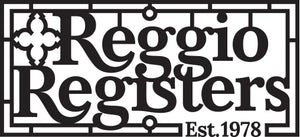Metal or Wood? A Buyer’s Guide to Choosing the Right Material for Your Registers
Thinking about giving your floor registers a much-needed update? If you’re in the market for new registers (also called grilles or vent covers) and you’ve just begun your research, one of the first decisions you’ll need to make is what material the register is made from.
The two most common materials used to make floor registers are metal and wood. The material not only dictates how your register will look, but it will also have an impact on air flow and the overall durability. Furthermore, the material also informs where you can use the register, as some models are better suited for the ceiling, while others are better for the floor.
Since material truly matters, we created a helpful buyer’s guide to choosing between metal or wood registers. What follows is a comparison of metal versus wood registers, including each material’s main pros and cons, so that you can confidently select the material that’s best for you!

Metal vent covers: pros & cons
Metal registers are often used for floors, as they are extremely durable and can handle plenty of foot traffic. Generally speaking, metal registers are made from cast iron, aluminum, or steel. Are metal vent covers right for your home? Let’s weigh the pros and cons:
What are the pros of metal grilles?
- Extra strong, meaning you won’t have to worry about heavy traffic, as they are weight-bearing and long-lasting
- For bathroom floors, metal grilles are a great choice as they are resistant to wetness, humidity, and rust
What are the cons of metal grilles?
- Extra heavy, which can drive up the price and make it more challenging to switch out;
- Limited style that doesn’t blend as well with wood floors;

Wood vent covers: pros & cons
If you’re hoping for a more natural look, wood registers are not only beautiful but also very durable. At Reggio Registers, we offer wood vent covers in oak, cherry, maple, or custom exotic woods from alder to walnut so you can customize the color and style to match perfectly with your home. Are you leaning towards wood covers? Here are some of the pros and cons:
What are the pros of wood grilles?
- Adds depth, texture, and a truly customized “built-in” feeling;
- Can be painted to match your existing decor, or easily repainted if you remodel your home later on;
- Extra durable no matter if they are placed in the floor or ceiling;
What are the cons of wood grilles?
- Needs proper ventilation in humid places like the bathroom, just like wood molding does;
Making your choice between metal versus wood
As you weigh all of these pros and cons, the choice comes down to your personal taste and the look you’re hoping to achieve.
Choosing wood registers will give your hardwood flooring a more seamless look, and the fact that they can be customized to match any color wood means they’ll blend so well you won’t even notice them! This is particularly important for homeowners who are aiming for cohesion and synchronicity in their interior design.
Choosing metal registers, on the other hand, will give any flooring an antique, even luxurious feel. Because they are specialty designs, metal vent covers look great with carpet, vinyl, and even stone flooring. Chances are, you’ll have some other decorative element that integrates metal (such as a lamp, table, or mirror) in the room where the new registers will go, making it easy to tie everything together with your existing color scheme.
Now that you know about the main differences between metal and wood registers, you’re ready to choose the material that’s ideal for you. If you’re leaning towards wood, shop our wood vent covers now.
